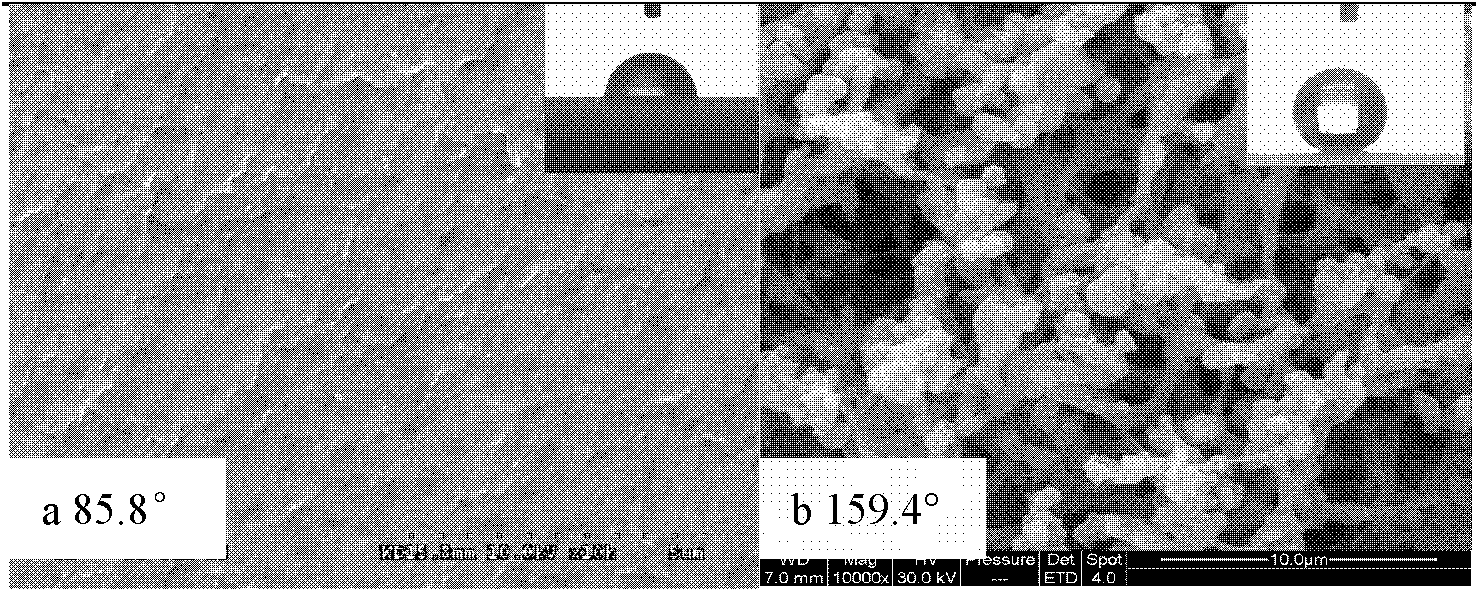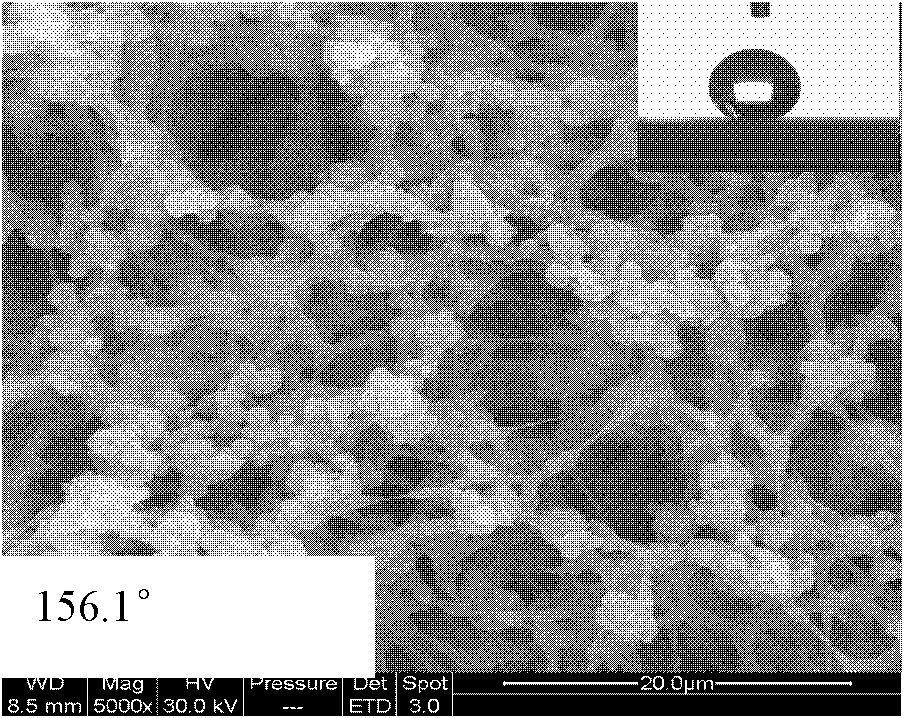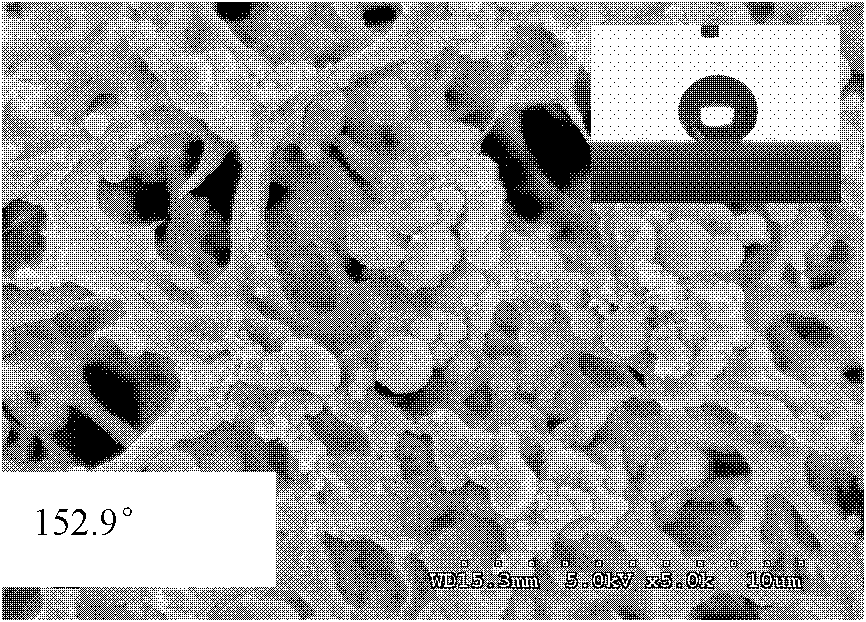Super hydrophobic modification method for polyvinylidene fluoride hydrophobic membranes
A polyvinylidene fluoride and hydrophobic membrane technology, which is applied in the field of separation membranes, can solve the problem of low hydrophobicity on the surface of PVDF microporous membranes, and achieve the effects of low cost, high desalination rate, and short process
- Summary
- Abstract
- Description
- Claims
- Application Information
AI Technical Summary
Problems solved by technology
Method used
Image
Examples
Embodiment 1
[0051] 1. Mix PVDF (7%), DMAC (56%) and 1,2-propanediol (40%), stir on a magnetic stirrer with heating for 6 to 7 hours, and control the temperature of the membrane liquid at 75°C, Obtain a clear and uniform casting solution, and then put the film solution in an oven at 60°C for 24 hours to fully mature and defoam, and then use it as the upper layer of the film solution;
[0052] 2. Mix PVDF (20%), DMAC (77%) and LiCl (3%), stir on a heated magnetic stirrer for 6-7 hours, and control the temperature of the film liquid at 75°C to obtain a clear and uniform cast film solution, and then put the membrane solution in an oven at 60°C for 48 hours to fully mature and defoam, and then use it as the lower layer membrane solution;
[0053] 3. Scrape the 75°C lower layer liquid film obtained in step 2 on a glass plate to form a 0.15mm thick lower layer liquid film, and at the same time scrape the 60°C film liquid in step 1 into an upper layer film liquid with a thickness of 0.04-0.05mm, ...
Embodiment 2
[0057] 1. Mix PVDF (4%), DMAC (66%) and ethylene glycol (30%), stir on a magnetic stirrer with heating for 6 to 7 hours, and control the temperature of the membrane liquid at 60°C to obtain clarification Uniform casting solution, and then put the film solution in an oven at 60°C for 48 hours to fully mature and defoam, and use it as the upper layer of film solution;
[0058]2. Mix PVDF (20%), DMAC (76%) and LiCl (4%), stir on a magnetic stirrer with heating for 6-7 hours, control the temperature of the membrane liquid at 60°C, and obtain a clear and uniform Cast the film solution, and then put the film solution in an oven at 60°C for 36 hours to fully mature and defoam, and then use it as the lower layer film solution;
[0059] 3. Scrape the 60°C film liquid obtained in step 2 on the glass plate to form a lower liquid film with a thickness of 0.16mm, and at the same time scrape the 60°C film liquid in step 1 to form an upper film liquid with a thickness of 0.04mm, and immediat...
Embodiment 3
[0063] 1. Mix PVDF (10%), DMAC (60%) and 1,2-propylene glycol (35%), stir on a magnetic stirrer with heating for 6 to 7 hours, so that the temperature of the membrane liquid is controlled at 60°C, Obtain a clear and uniform casting solution, and then place the film solution in an oven at 60°C for 36 hours to fully mature and defoam, and then use it as the upper layer of the film solution;
[0064] 2. Mix PVDF (20%), DMAC (78%) and LiCl (2%), stir on a magnetic stirrer with heating for 6 to 7 hours, and control the temperature of the membrane liquid at 60°C to obtain a clear and uniform Cast the film solution, and then put the film solution in an oven at 60°C for 24 hours to fully mature and defoam, and then use it as the lower layer film solution;
[0065] 3. Scrape the 60°C film liquid obtained in step 2 on the glass plate to form a lower liquid film with a thickness of 0.16 mm, and at the same time scrape the 60°C film liquid in step 1 to form an upper film liquid with a thi...
PUM
| Property | Measurement | Unit |
|---|---|---|
| Contact angle | aaaaa | aaaaa |
Abstract
Description
Claims
Application Information
 Login to View More
Login to View More - R&D
- Intellectual Property
- Life Sciences
- Materials
- Tech Scout
- Unparalleled Data Quality
- Higher Quality Content
- 60% Fewer Hallucinations
Browse by: Latest US Patents, China's latest patents, Technical Efficacy Thesaurus, Application Domain, Technology Topic, Popular Technical Reports.
© 2025 PatSnap. All rights reserved.Legal|Privacy policy|Modern Slavery Act Transparency Statement|Sitemap|About US| Contact US: help@patsnap.com



